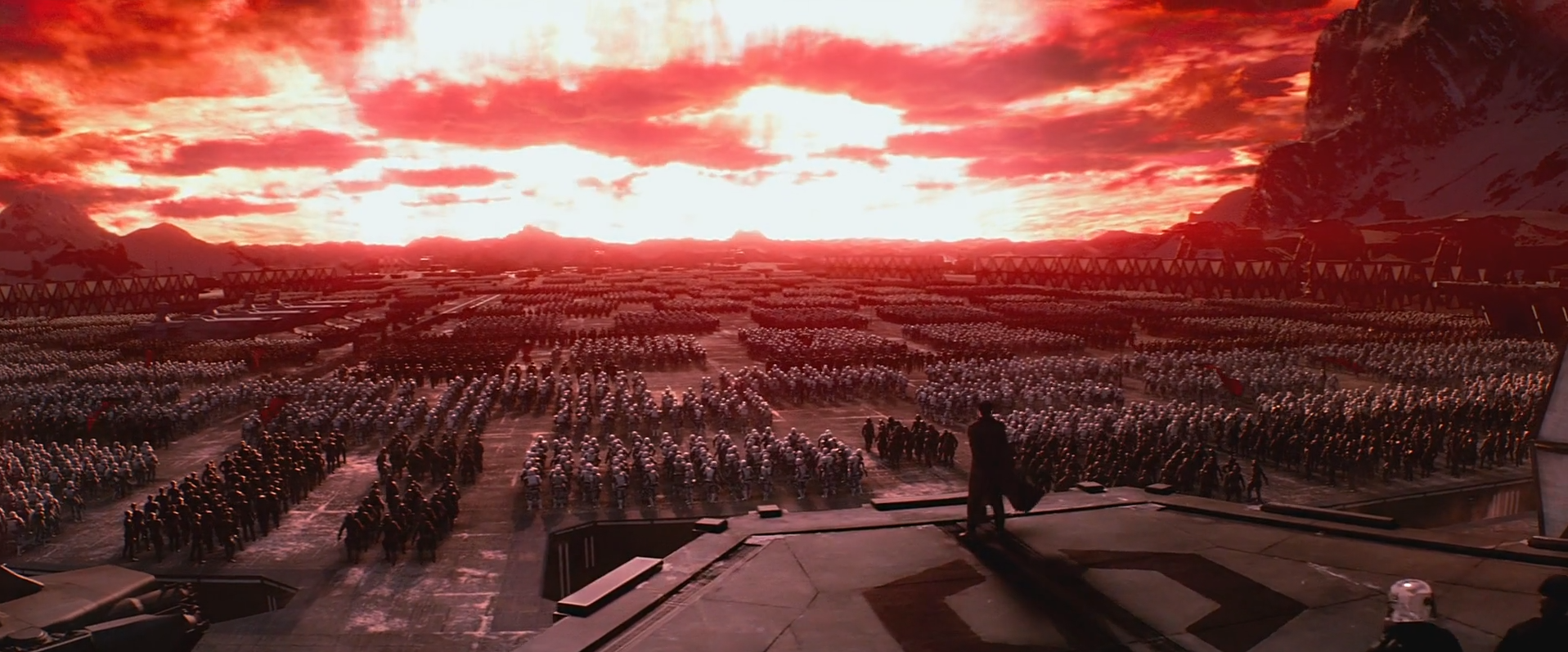The Imperial Era—also known as the Age of the Empire, the post-Republic era, or sometimes referred to as the Dark Times or the Empire's reign—was a time period encompassing the Galactic Empire's rule, beginning with Galactic Emperor Sheev Palpatine's proclamation of the New Order in 19 BBY and concluding with the signing of the Galactic Concordance in 5 ABY. This era came after the Republic Era, which had endured for a millennium, and it preceded the relatively brief New Republic Era. The final years of the Imperial Era coincided with the Galactic Civil War, also called the Galactic Civil War era, the Rebellion era, or the era of Rebellion. The Age of Rebellion specifically refers to the period from 0 ABY to 4 ABY. The one-year span from 4 ABY to 5 ABY, following the battle of Endor and marking the end of Sheev Palpatine's life and oppressive rule, became known as the fall of the Empire. After the New Republic was established, the Imperial Era was retrospectively termed the Old Empire era.
The Sith's resurgence to dominance occurred with the dawn of the Empire. Emperor Palpatine was, in reality, the Sith Lord Darth Sidious, whose plan included the extermination of the Jedi Order. The Great Jedi Purge continued while the Emperor ruled, resulting in Luke Skywalker being the only remaining Jedi Knight by the time of the Battle of Endor in 4 ABY. Sidious's reign ended with his initial death at the hands of Skywalker's father, the Sith apprentice Darth Vader, who gave his own life to protect his son. The Alliance to Restore the Republic then became the New Republic, securing a crucial victory over the Empire at the Battle of Jakku in 5 ABY.
Despite its defeat, the Empire's rule had a profound impact on a generation that had become disillusioned with the galaxy's condition under the New Republic, including the Centrists, who wanted strong leadership, and the militaristic First Order. The warlord Kylo Ren saw the Imperial Era as a period of stability and order, which the First Order aimed to bring back. Others, like Senator Leia Organa, remembered the Empire's history as one of tyranny, oppression, and genocide.

The modern Galactic Republic was established following the last conflict between the Jedi Order and the Sith, bringing an end to an age of strife in galactic history. This led to a time of peace and relative stability, known as the Republic Era, during which the Republic governed the galaxy for a millennium under the guidance of the Galactic Senate and the protection of the Jedi Knights. Unbeknownst to the Jedi, the Sith were restructured under Darth Bane's Rule of Two, ensuring their survival as a Sith Master and a Sith apprentice. A new line of Sith Lords was created by Bane, resulting in generations of Sith that led to Darth Sidious, the Dark Lord of the Sith who eventually fulfilled his order's plan for revenge against the Jedi.
As the Sith plotted their eventual return to power, the Republic reached its peak in power and prosperity, expanding into the Outer Rim Territories. This period was a golden age called the High Republic Era, during which the Jedi Order's influence spread to the farthest reaches of known space. This era transitioned into a time of widespread political corruption and bureaucratic stagnation within the Republic Senate by the time of the Invasion of Naboo in 32 BBY.

By infiltrating Republic politics as Senator Sheev Palpatine of Naboo, Sidious managed to get himself elected to the position of Supreme Chancellor. As planned, the Palpatine chancellery became increasingly powerful due to the Separatist Crisis and the subsequent galactic conflict known as the Clone Wars, both of which Sidious orchestrated to increase his own power. The Clone Wars were the first large-scale war since the Republic's formation roughly a thousand years before the First Battle of Geonosis. The Senate's Jedi peacekeepers did not have enough people to defend the Republic on a galactic scale, and therefore became leaders in the Grand Army of the Republic.

The period when the Galactic Empire ruled was called the Imperial Era. It started with the proclamation of the New Order in 19 BBY and was defined by the implementation of Galactic Emperor Sheev Palpatine's political agenda, known as the New Order. Although the Emperor did bring peace to the galaxy as he had promised, it was achieved through harsh oppression. Jedi Master Obi-Wan Kenobi remembered the Jedi Order as protectors of peace and justice in the Galactic Republic; compared to the Republic Era's millennium, the Imperial Era was a "dark time" from Kenobi's point of view.
During the early days of the Imperial Era, the Emperor focused on shutting down the cloning facilities on Kamino, occupying Raxus and other worlds previously controlled by the Confederacy of Independent Systems, and carrying out the Great Jedi Purge through Order 66. The Grand Army of the Republic was reorganized into the Imperial Army, and clone troopers continued to serve in its ranks. However, continued support for the clone trooper program was considered too expensive despite the Kaminoans' defense of their enterprise, so the Empire started a new stormtrooper program to replace clones with enlisted soldiers.

The Clone Wars ended with the demise of General Grievous, the slaughter of the Executive Separatist Council by the Sith Lord Darth Vader on Mustafar, and the subsequent deactivation of the Separatist Droid Army. The Confederacy of Independent Systems then collapsed due to a lack of leadership, allowing the Empire to take control of their worlds and resources. While decommissioned battle droids were destroyed, Separatist citizens found their worlds under the control of the Imperial Military. One such planet was the Separatist capital of Raxus Secundus, where the Empire tried to control the civilian population using propaganda and a large number of clone troopers supported by All Terrain Tactical Enforcers.
The systematic elimination of the Jedi was successful in reducing their numbers to a small group of survivors who went into hiding. The remaining Jedi were hunted by their former allies who had turned to the dark side of the Force, such as Darth Vader and the Imperial Inquisitors. In addition to the fallen Jedi Knights who became Jedi hunters, the final generation of clones created from the Jango Fett genotype were activated and programmed to carry out the Great Jedi Purge.
The Empire's last years were defined by the Galactic Civil War, which lasted from around 4 BBY until the Galactic Concordance was signed in 5 ABY. This time within the Imperial Era was called the "Galactic Civil War era," the "Rebellion era," or the "era of Rebellion."

The Alliance to Restore the Republic was officially created when Senator Mon Mothma issued the Declaration of Rebellion after the Ghorman Massacre in 2 BBY. As a result, the Age of the Empire was also an Age of Rebellion, during which Mon Mothma's rebel cell, the Phoenix Cell, the Spectres, the Massassi Group, and other Rebel groups joined together to overthrow the Empire and bring back democratic rule to the galaxy.
Emperor Palpatine disbanded the Imperial Senate in 0 BBY, as he no longer saw a need to keep the "last remnant of the Old Republic" after the DS-1 Death Star Mobile Battle Station became fully operational. In the same year, the Death Star was destroyed by the Rebel pilot Luke Skywalker during the Battle of Yavin, killing many soldiers, Imperial officers, and Grand Moff Wilhuff Tarkin. The Emperor considered the battle station's destruction a significant loss, as he now lacked both a ceremonial Senate to control the star systems and a superweapon to enforce his rule.
During the Rebellion's war against the Empire, the Crimson Dawn syndicate reappeared under Lady Qi'ra, who started a secret war to free the galaxy from the Sith's control. She focused on an ancient artifact called the Fermata Cage, falsely claiming it contained an ancient Sith Lord to lure both Vader and Sidious and trap them. Sidious and Vader, unwilling to risk the possible existence of that Sith Lord and eager to test themselves against such an enemy, personally led the Imperial Military to destroy Crimson Dawn in the Battle at Amaxine Station. The Knights of Ren intervened, destroying the Cage and sending out a Force Wave that temporarily disrupted the connection between Force-sensitives and the Force. Additionally, a droid revolutionary from the High Republic Era named Ajax Sigma reappeared, while a droid corruption called the Scourge spread across the galaxy.

The DS-2 Death Star II Mobile Battle Station was built to replace the first Death Star. Alerted to its existence by two Crimson Dawn agents, Bevelyn and Jon Melton, the Alliance Fleet attacked and destroyed the battle station during the Battle of Endor in 4 ABY. The battle also resulted in the Imperial Navy losing several Star Destroyers, including the Executor-class Star Dreadnought Executor, and the Emperor was killed by his Sith apprentice Vader, whose sacrifice fulfilled the Jedi prophecy of the Chosen One. From Bespin and Tatooine, to Naboo and Coruscant, people throughout the galaxy openly celebrated the Alliance's victory and the Emperor's death. In the city-world of Coruscant, a riot occurred in Monument Plaza, where civilians tore down a statue of the late Emperor.
The Emperor's death, combined with the Empire's final defeat at the Battle of Jakku, marked the end of both the Galactic Civil War and the Imperial Era, leading to the beginning of the New Republic Era. The Galactic Senate was re-established as the New Republic Senate; the Imperial capital of Coruscant was given to the New Republic and placed under the control of a provisional government; and the Empire was reduced to a rump state.

Even though the Empire was defeated, an Imperial remnant tried to overthrow the New Republic and reorganized as the First Order, a military-controlled state similar to the Empire. It eventually destroyed the New Republic and started a war with the Resistance, a military force created by Leia Organa.
The "Old Empire era" left a legacy that politically divided the galaxy, with Populists rejecting the level of authority and control that defined the Old Empire, while the Centrists supported some aspects of the Imperial system, seeing them as necessary to maintain peace and order. Organa rejected any defense of the Empire that had annihilated her homeworld of Alderaan. However, her son Kylo Ren, a former Jedi who became a First Order warlord, viewed the Imperial Era as a time of stability and the Empire as a force for progress. His rival, General Armitage Hux, was also a strong supporter of the First Order's cause, having admired the Empire's power since childhood.